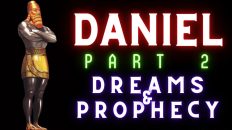Written in 537 B.C. during the time of the Hebrew’s Babylonian captivity the text introduces the reader to Daniel and three of his fellow countrymen who were taken captive in their youth from their home in the southern kingdom of Judah. Daniel lived more than 80 years in the pagan city-state, Babylon, near modern-day Iraq. The reader encounters life in the Ancient Near East, pagan traditions of worship, various styles of government, conquering forces, and details of a life of faith, character, and duty in the midst of tyranny, false worship, and severe oppression.
Daniel’s writing is known as apocalyptic literature revealing prophecies, or symbolic foretellings regarding the end of the age. Jesus identified this same Daniel as a prophet, however, the text was not included in the prophecy division of the Hebrew Bible. The coming of Christ is certainly in view from the 2nd chapter forward and we are also blessed with Daniel’s personal example of a life of uncompromising faith in Yahweh, the “God of heaven” (ch. 2), “God of gods” (ch. 2, 11), “Lord of Kings” (ch. 2), “The Most High God,” (ch. 3, 4, 5, & 7) “King of Heaven” (ch. 4).
As amazingly accurate as the prophecies are, believers benefit greatly in the here and now from the great faith shown by Daniel and his three friends in the face of forced false worship, oppression, death, and in the grace of God’s blessings upon those who serve Him.
_______________________________________________________________________________________________________________
Outline: Introduction to the text & Study of Chapter 1
I. Purpose:
A. Understand prophetic symbols
B. Gain a clearer understanding of Jesus Christ
C. Discern context of end-times
D. Gain knowledge of the A.N.E. to validate Scripture
E. How does God give prophecy?
1. figures, types, symbols
2. promises
3. parables
4. direct revelation
5. story/allegory
II. Special Revelation (Two kinds of revelation: General & Special)
A. What does the Bible say?
1. Jesus Christ and the OId Testament
2. God Has Spoken – Theopneustos
3. Moved By God
4. Believing The Bible
5. Prophecy
a. What is prophecy?
b. How can we trust that Biblical prophecy can predict the future?
B. Prophetic significance of Daniel
1. Ch. 2 broad outline of human history
2. Ch. 7 elaborates on a certain period of end time
3. Ch. 8 & 9 adds further details on end time
4. Ch. 10-12 further expansion on the end time
III. Context: The Ancient Near East: A Comparative Look
A. Why Should We?
1. Defense of the Biblical Text
2. Exegesis of the Biblical Text
B. Overview of the Literature of The A.N.E.
1. Myths: stories in which the gods are the main characters
a. The Gods of the A.N.E.
i. Primarily Marduk, Ishtar, Shamash
ii. How Yahweh differs from the ANE gods
b. Temples and Rituals
c. State and Family Religion
d. State Religion in Israel
e. Abraham’s Religion
IV. Book of Daniel Chapter 1
A. Authorship and Background Information/Context
B. Theme (ESVARCHSB 1201)
C. Contributions from Archaeology (ESV 1201)
D. Outline (ESVARCHSB 1201)
E. Immediate Historical Context of the Book of Daniel
F. The Text of Scripture: Daniel Chapter 1
G. Daniel finds favor in Babylon
H. General Summary and Review
_______________________________________________________________________________________________________________
Resources
- Akin, D. L. (2014). Theology for the church. Nashville, TN:
B & H Academic. BARNES, I. (2019). - HISTORICAL ATLAS OF THE BIBLE:
The fascinating history of the scriptures. CHARTWELL Books. - Boice, J. M., & Ryken, P. G. (2019).
Foundations of the Christian faith: A comprehensive & readable theology.
Downers Grove, IL: An Imprint of InterVarsity Press. - Book of Daniel. (2011). In ESV Archaeology Study Bible:
English Standard Version. Wheaton, IL: Crossway. - King James Version with Strong’s (KJVS)
Public Domain - The encyclopedia of Ancient Egypt. (2006).
London, England: Amber Books. - McGrath, A. E. (2018). Theology: The basics.
Hoboken, NJ: John Wiley & Son. - Walton, J. H. (2018). Ancient Near Eastern Thought and the Old Testament:
Introducing the conceptual world of the Hebrew Bible.
Grand Rapids, MI: Baker Academic. - White, C. (2013). Daniel: A Commentary.
CWM Publishing.
Websites For Deeper Study
BIBLICAL ARCHAEOLOGY SOCIETY
50 People In The Bible Confirmed Archaeologically
Daniel and Belshazzar in History
THE BIBLICAL REVIEW
Biblical Review: Babylon
_______________________________________________________________________________________________________________
#BookOfDaniel #BibleStudy #BradfromCarolina




Add comment